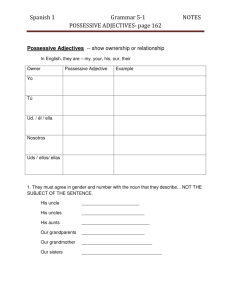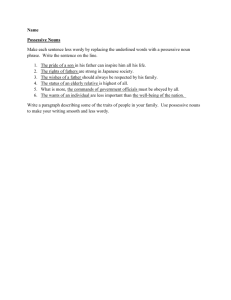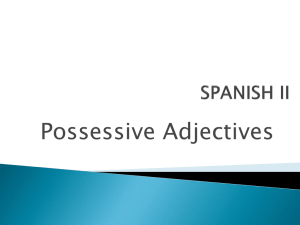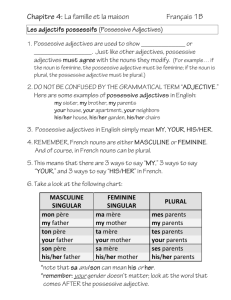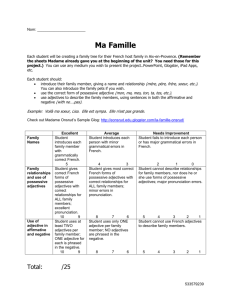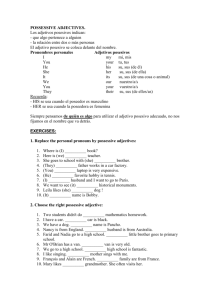What IS a possessive adjective?
advertisement
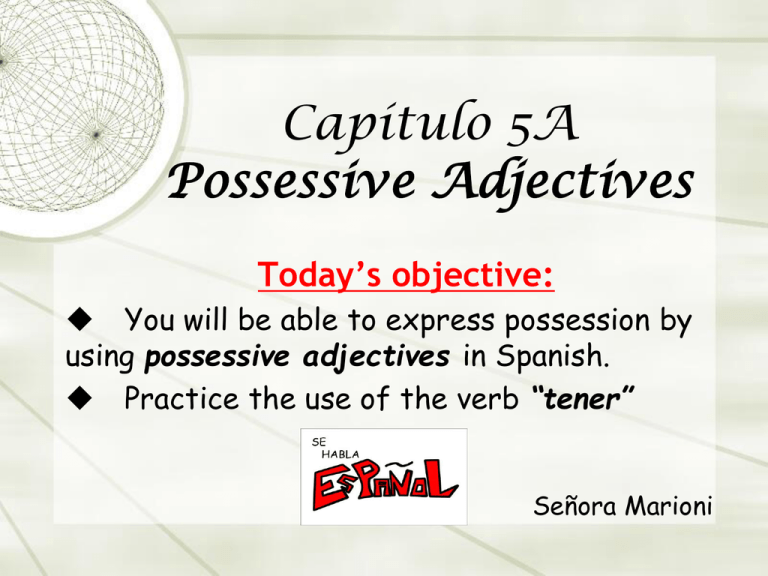
Capítulo 5A Possessive Adjectives Today’s objective: You will be able to express possession by using possessive adjectives in Spanish. Practice the use of the verb “tener” Señora Marioni What IS a possessive adjective? In English, we use possessive adjectives all th time, though we probably haven’t always known that they had a name. Examples of English possessive adjectives are: My, your, his, her, our, and their Can’t we just memorize them in Spanish? Yes and No. As with all adjectives in Spanish, possessive adjectives MUST AGREE WITH THE NOUNS THEY MODIFY IN BOTH NUMBER AND GENDER! This means that the possessive adjective you use will depend on the gender and the number of the noun that comes after it. Where do we begin? Let’s start with the possessive adjective for “my” In Spanish it is either mi or mis The gender of the noun has no effect on the possessive adjective in this case, only the number. Can I get an example? Here we go: While you would say “Mi lapiz” for “my pencil” you would say “mis libros” for “my books” because the noun is plural in the second example. What about “your” It works the same way as “my,” except spelled slightly different: “your” is: tu or tus “tu zapato” “tus zapatos” His and her? Again, only the number makes a difference here. And, his and her is the same, regardless of whether it is a boy or a girl in possession of the object. For his/her: su or sus “su cuaderno” “sus primos” Finally, a more complicated possessive adjective “our” has four different translations in Spanish. They are: nuestro nuestra nuestros nuestras As you can see, the adjective you use will depend on whether the noun that follows is masculine or feminine, singular or plural. Looks like this: “nuestro libro” “nuestra familia” “nuestros abuelos” “nuestras hermanas” A basic rule of thumb on this is that if the noun ends in o/a/os/as, then so does the possessive adjective. Finally…the last one “Their” is written exactly like “his/her” su or sus “their dog” is “su perro” “their cats” is “sus gatos” A warning/AVISO Many people make the mistake of thinking that the owner of the object makes the difference in the number of the possessive adjective. For example, people think that “their book” is “sus libro” because “they” is plural. Remember, it is the noun that follows the adjective that determines the plurality/singularity of the adjective. Shall we give it a try? Please use the following questions as a self-test to make sure you understand the concept of possessive adjectives Let’s give it a shot Click the button next to the correct translation: “Your mom is in front of our house.” Su cocina está enfrente de nuestra casa. Tu mamá está enfrente de nuestra casa. Su mamá está enfrente de nuestro casa. Tus mamá está enfrente de nuestra casa. Bogus You might want to go back to the beginning and give the tutorial another look. Beginning Back to question End of show Oh brother! You might want to go back to the beginning and give the tutorial another look. Beginning Back to question End of show D’Oh! You might want to go back to the beginning and give the tutorial another look. Beginning Back to question End of show Nice! Exactly right. You’re ready to go on to the next question. Go On Next one: Their books are next to our desks. Sus libros están al lado de nuestro pupitres. Su libros están al lado de nuestros pupitres. Sus libros están al lado de nuestras pupitres. Sus libros están al lado de nuestros pupitres. Bogus We might want to go back to the beginning and go over this again! Beginning Back to question End of show D’Oh! You might want to go back to the beginning and give this lesson another look. Beginning Back to question End of show Oh brother! You might want to go back to the beginning and give this lesson another look. Beginning Back to question End of show Nice! Exactly right. You’re ready to tackle possessive adjectives Go On That’s just about it! Tarea: Complete worksheet on possessive we will give you at the end of the period. Exámen del capítulo 5A el martes 11 de octubre İ ANOTEN EN SU AGENDA DE TAREA ! EXPRESSING POSSESSION

